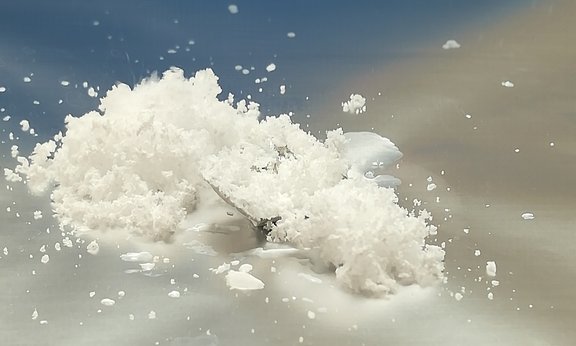
Amorphous ice such as that found in interstellar dust or on the surface of Jupiter's moon Europa.
Possible water deposits in space play a central role in the question of extraterrestrial life. New data from the University of Innsbruck help find traces of water in astronomical observations. A research group led by Christina M. Tonauer and Thomas Lörting has published near-infrared spectra of different forms of ice. They can be used to better classify data from the James Webb Space Telescope.
Thomas Lörting's research group at the Institute of Physical Chemistry at the University of Innsbruck deals with the diverse and special properties of ice and water. The scientists have discovered new forms of ice in the laboratory and have previously shown that water consists of two different liquids. The working group is able to produce ice forms in the laboratory that do not occur naturally on Earth, but are found in outer space. “The production of these ice blocks requires very low temperatures and/or very high pressures,” explains chemist Christina M. Tonnauer from Thomas Lörting's team. The findings on ice forms are used in various fields. They are important for space research because they allow us to understand under what conditions ice forms and where it can be found.
Twenty different forms of ice are known to date. While only so-called hexagonal ice has been observed on Earth’s surface, science suspects that a variety of different ice structures exist in the interiors of the ice giants Uranus and Neptune or on the icy moons of Jupiter and Saturn, which are covered by a kilometre-thick layer of ice. For the first time, chemists in Innsbruck have now presented spectra of these ice forms in the near-infrared range, a frequency range that the new James Webb Space Telescope also measures. The data measured in space can be compared with the spectra determined in the laboratory in Innsbruck, thus providing data on the type and structure of ice in space.
A new measurement method has been developed.
Christina M. Tonauer was able to create the near-infrared spectra in collaboration with the research group led by Christian Haacke at the Institute of Analytical Chemistry and Radiochemistry at the University of Innsbruck, which specializes in near-infrared spectroscopy. “The biggest difficulty was to keep the ice at minus 196 degrees Celsius for the entire measurement period so that it did not deform,” says Christina M. Tonauer. “We had to develop a method to measure the samples using liquid nitrogen in a spectrometer designed for room temperature.”
The scientists were able to find several distinctive features in the spectra in the wavelength range of 1 to 2.5 micrometres, which can be used to determine the density and porosity of the ice. “One of the spectrometers on the James Webb Space Telescope also measures this wavelength range,” explains Thomas Lörting. “Our laboratory data can be used as reference values to interpret measurements in space. So we may soon learn more about ice and water in space.”
The research was carried out as part of the Materials and Nanoscience Research Platform at the University of Innsbruck, which was upgraded to the research focus Functional Materials Science (FunMAT) at the beginning of the year.
Publishing: Near-infrared spectroscopy for remote sensing of porosity, density, and cubicity of crystalline and amorphous ice H2O in the astrophysical environment. Christina Tonauer et al. The Astrophysical Journal 2024 DOI: 10.3847/1538-4357/ad4f82

“Social media evangelist. Baconaholic. Devoted reader. Twitter scholar. Avid coffee trailblazer.”







More Stories
Longest jets in the universe discovered – giant particle streams as long as 140 Milky Way galaxies in a row
New method reveals 307 supernova remnants
Snapchat is upping the ante on augmented reality glasses